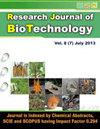Diabetic wound healing activity of Elaeagnus conferta Roxb. leaf ethanol extract
IF 0.2
Q4 Biochemistry, Genetics and Molecular Biology
引用次数: 0
Abstract
High blood glucose level and gangrene wounds are becoming difficult to cure for the medical sciences nowadays. The goal of the current study is to assess the diabetic wound healing activity of Elaeagnus conferta leaf ethanol extract (LEE). The qualitative and quantitative phytochemical screening of the LEE revealed the presence of total phenols (42.20 ± 1.3 μg/gm) and flavonoids (45.23 ± 1.2 μg/gm). HR-LCMS analysis of the LEE revealed the presence of 27 phytoconstituents, among them Telmisartan was expressed with higher concentration. Alloxan monohydrate induced diabetic rats were administered with LEE of Elaeagnus conferta and the extract was locally applied to excision, incision and dead space wound models of diabetic rats. LEE at the concentration of (200 mg /kg. /bw.) significantly reduced the blood glucose levels when compared to the untreated diabetic group. In excision wound models on 21st day of treatment, the percentage of epithelization was increased to 99.86±0.08 and in the incision model, tensile strength of the wound was increased to 798.7±37.08gm as compared to Povidine iodine ointment. In slico molecular docking studies of the Telmisartan ligand with the glycogen synthase kinase- 3 protein resulted with 2 hydrogen bonds and 13 hydrophobic interactions indicating the suppression of wound enhancing protein. Present study authenticates the antidiabetic property and wound healing efficacy of E. conferta leaf ethanol extract.沙棘糖尿病创面愈合活性研究。叶乙醇提取物
高血糖和坏疽是目前医学上难以治愈的疾病。本研究的目的是评估白菖蒲叶乙醇提取物(LEE)的糖尿病伤口愈合活性。经定性和定量筛选,发现总酚含量为42.20±1.3 μg/gm,总黄酮含量为45.23±1.2 μg/gm。经HR-LCMS分析,发现含有27种植物成分,其中以替米沙坦浓度较高。采用四氧嘧啶一水诱导的糖尿病大鼠灌胃沙棘LEE,并将其提取物局部应用于糖尿病大鼠的切除、切口和死腔创面模型。LEE浓度为200mg /kg。/体重)显著降低血糖水平,与未经治疗的糖尿病组相比。治疗第21天,与聚维碘膏相比,切除创面的上皮细胞百分率提高到99.86±0.08,切口创面的抗拉强度提高到798.7±37.08gm。在替米沙坦配体与糖原合成酶激酶- 3蛋白的分子对接研究中,发现2个氢键和13个疏水相互作用,表明对伤口增强蛋白的抑制。本研究验证了牛蒡叶乙醇提取物的抗糖尿病作用和创面愈合作用。
本文章由计算机程序翻译,如有差异,请以英文原文为准。
求助全文
约1分钟内获得全文
求助全文
来源期刊

Research Journal of Biotechnology
工程技术-生物工程与应用微生物
CiteScore
0.60
自引率
0.00%
发文量
192
审稿时长
1.5 months
期刊介绍:
We invite you to contribute Research Papers / Short Communications / Review Papers:
-In any field of Biotechnology, Biochemistry, Microbiology and Industrial Microbiology, Soil Technology, Agriculture Biotechnology.
-in any field related to Food Biotechnology, Nutrition Biotechnology, Genetic Engineering and Commercial Biotechnology.
-in any field of Biotechnology related to Drugs and Pharmaceutical products for human beings, animals and plants.
-in any field related to Environmental Biotechnolgy, Waste Treatment of Liquids, Soilds and Gases; Sustainability.
-in inter-realted field of Chemical Sciences, Biological Sciences, Environmental Sciences and Life Sciences.
-in any field related to Biotechnological Engineering, Industrial Biotechnology and Instrumentation.
-in any field related to Nano-technology.
-in any field related to Plant Biotechnology.
 求助内容:
求助内容: 应助结果提醒方式:
应助结果提醒方式:


